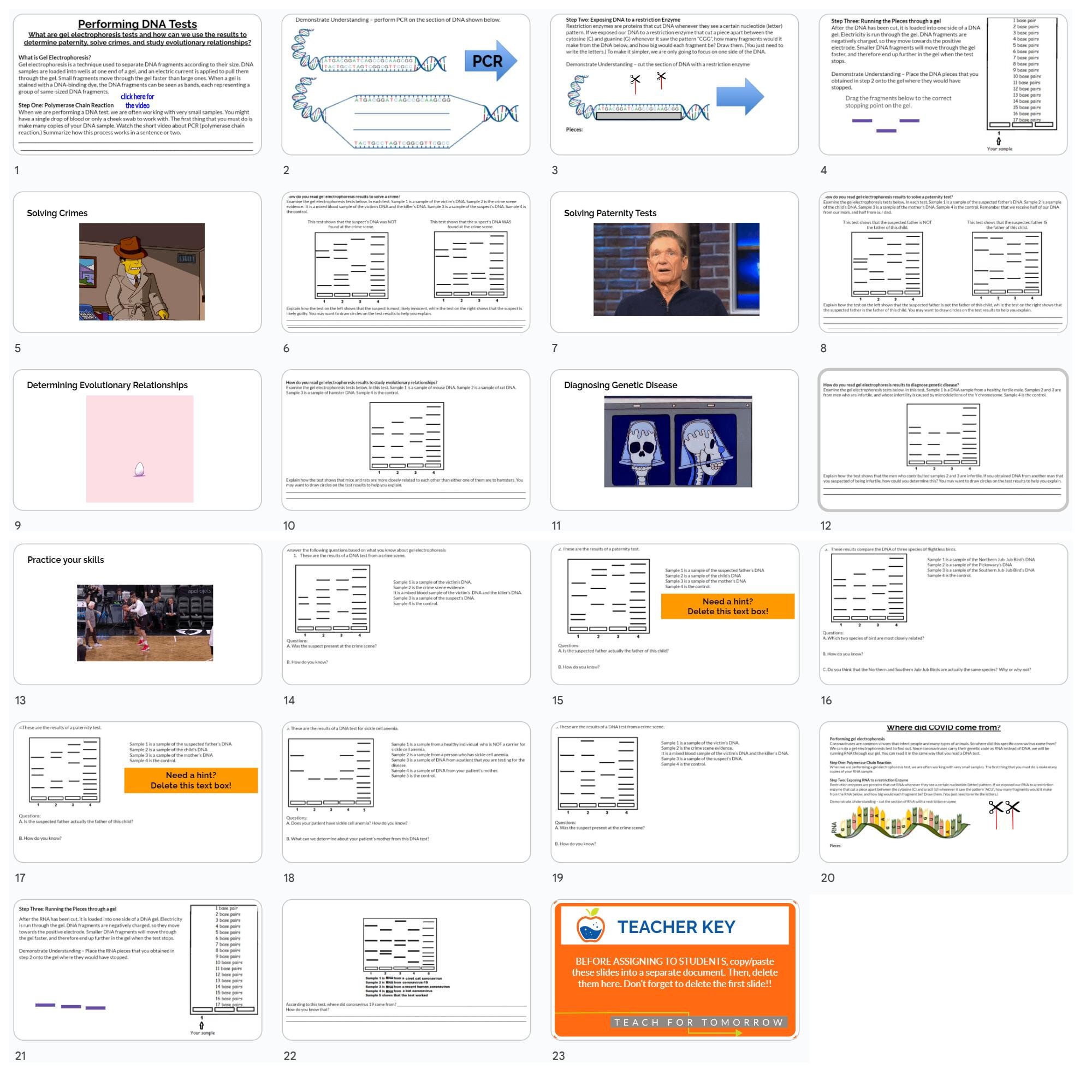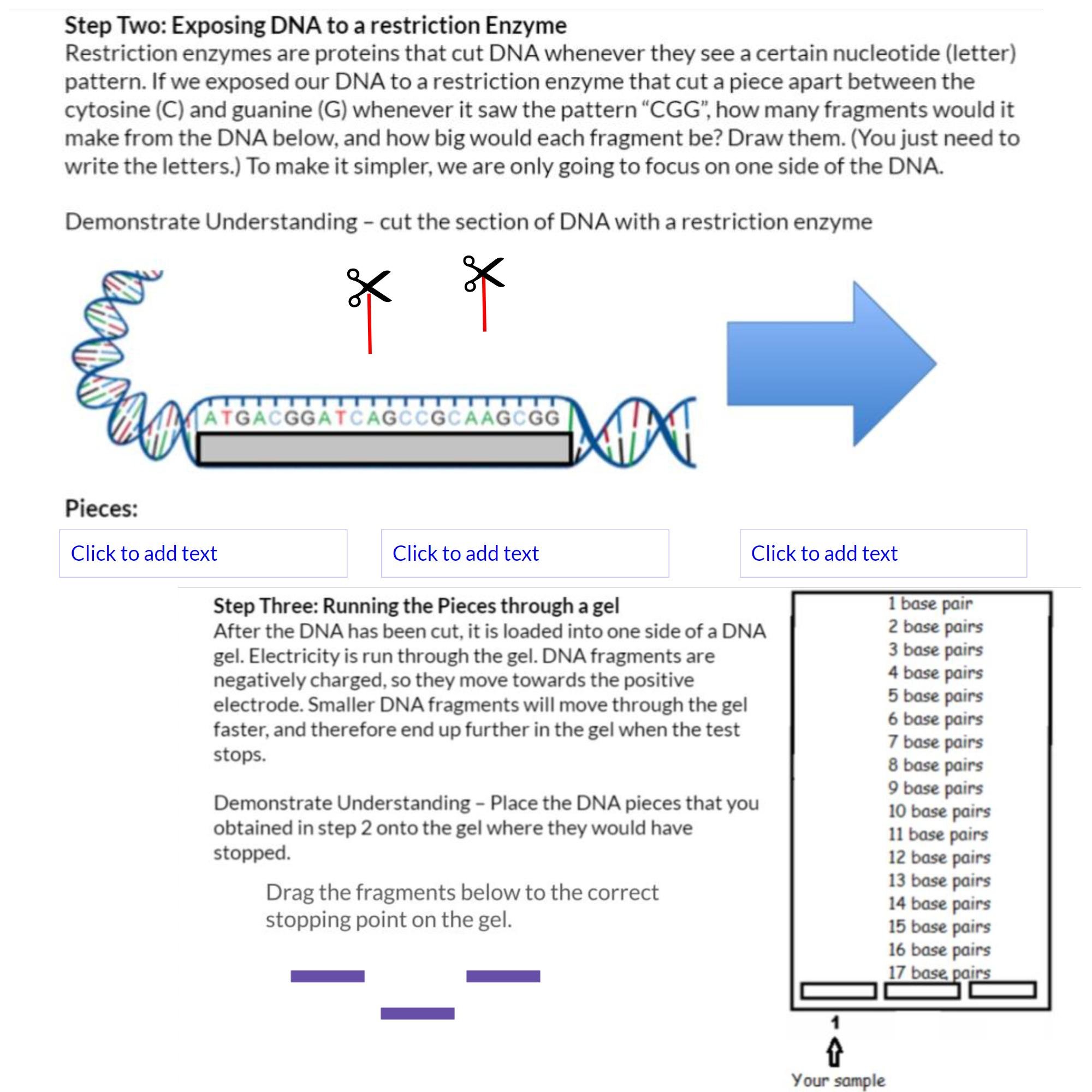



How to Perform DNA tests- PCR and Gel Electrophoresis
Unlock the Secrets of Gel Electrophoresis: An Interactive Google Slides Lesson!
Explore the World of DNA Analysis: Dive into the fascinating realm of gel electrophoresis with our engaging and remote learning-ready Google Slides lesson. This interactive journey empowers students to master the art of creating and interpreting gel electrophoresis tests.
Step-by-Step Learning Adventure:
PCR Demystified: Kickstart the lesson by having students watch a video explaining Polymerase Chain Reaction (PCR) and describe the process.
Hands-On PCR: Dive deeper into a simulated PCR experience, where students write the complementary DNA strands, reinforcing their understanding of this crucial technique.
✂️ Restriction Enzyme Mastery: Students learn to wield 'restriction enzymes' like a pro, cutting DNA strands and counting nucleotides in each piece.
Gel Electrophoresis Made Easy: Students put their newfound skills to the test by dragging 'bands' to their rightful place on a gel, just like a real scientist.
Crack the Cases: Students solve intriguing cases involving gel electrophoresis. They analyze crime scene evidence, paternity tests, and evolutionary studies to draw their conclusions. Watch as your students are inspired to discover the art of reading gel electrophoresis results independently.
Skill Sharpening: Students hone their abilities with five practice problems to ensure mastery.
Real-World Application: Acting as real research scientists, students contribute to the fight against COVID-19 by conducting a gel electrophoresis test on the virus's RNA to determine its origin species.
Why Choose Our Lesson?
Engaging Exploration: A dynamic, inquiry-inspired approach ensures students are active participants in their learning journey.
Comprehensive Learning: From PCR to real-world applications, this lesson covers it all, providing students with a robust understanding of gel electrophoresis.
Critical Thinking: Encourages independent thinking and problem-solving skills.
Remote Learning Ready: Perfect for both in-class and remote learning environments.
Empower Your Students: Equip your learners with invaluable skills in DNA analysis. Download our interactive lesson now and watch their scientific prowess soar!
Grade & Course Recommendation:
Middle School: Grade 8 Honors or Enrichment, simplified overview of biotechnology processes.
High School: Grades 9–10 Biology or Forensics, molecular genetics or applied biology unit.
Cross-Curricular Connections:
Technology Integration: Demonstrates the use of digital modeling for lab processes.
Math Integration: Introduces concepts of molecular weight and gel band measurement.
ELA Integration: Students explain procedure steps and interpret visual data.
Daily slide + literacy - based exit ticket included with purchase
Join the Lesson Laboratory and Teach for Tomorrow!
NGSS (Next Generation Science Standards)
High School NGSS Alignment
HS-LS1-1: Construct an explanation based on evidence for how the structure of DNA determines the structure of proteins, which carry out the essential functions of life.
Students analyze how specific DNA sequences are amplified and visualized to identify genetic differences and similarities.HS-LS3-1: Ask questions to clarify relationships about the role of DNA and chromosomes in coding the instructions for traits.
Students explore how PCR and gel electrophoresis reveal variations in genetic information.HS-LS3-3: Apply concepts of statistics and probability to explain the variation and distribution of expressed traits in a population.
Students examine how differences in DNA banding patterns reflect inheritance and genetic variation.HS-LS4-1: Communicate scientific information that common ancestry and biological evolution are supported by multiple lines of empirical evidence.
Students compare banding patterns across species to determine evolutionary relationships.
Science and Engineering Practices:
Analyzing and interpreting data (banding patterns, gels)
Constructing explanations
Engaging in argument from evidence
Communicating scientific information
Crosscutting Concepts:
Patterns (in banding and inheritance)
Structure and function (DNA, enzymes, electrophoresis gel)
Cause and effect
Common Core Standards
Grades 9–12:
CCSS.ELA-LITERACY.RST.9-10.1 / RST.11-12.1: Cite specific textual or visual evidence to support analysis of science and technical texts.
CCSS.ELA-LITERACY.RST.9-10.7 / RST.11-12.7: Translate quantitative or technical information expressed in words into visual form (e.g., interpreting gels and PCR diagrams).
CCSS.ELA-LITERACY.RST.9-10.9 / RST.11-12.9: Compare and contrast findings from multiple sources. (Students analyze how PCR and electrophoresis apply to different real-world cases.)
CCSS.ELA-LITERACY.WHST.9-10.2 / WHST.11-12.2: Write informative/explanatory texts to convey complex scientific processes clearly. (Students explain how PCR or electrophoresis works.)
Unlock the Secrets of Gel Electrophoresis: An Interactive Google Slides Lesson!
Explore the World of DNA Analysis: Dive into the fascinating realm of gel electrophoresis with our engaging and remote learning-ready Google Slides lesson. This interactive journey empowers students to master the art of creating and interpreting gel electrophoresis tests.
Step-by-Step Learning Adventure:
PCR Demystified: Kickstart the lesson by having students watch a video explaining Polymerase Chain Reaction (PCR) and describe the process.
Hands-On PCR: Dive deeper into a simulated PCR experience, where students write the complementary DNA strands, reinforcing their understanding of this crucial technique.
✂️ Restriction Enzyme Mastery: Students learn to wield 'restriction enzymes' like a pro, cutting DNA strands and counting nucleotides in each piece.
Gel Electrophoresis Made Easy: Students put their newfound skills to the test by dragging 'bands' to their rightful place on a gel, just like a real scientist.
Crack the Cases: Students solve intriguing cases involving gel electrophoresis. They analyze crime scene evidence, paternity tests, and evolutionary studies to draw their conclusions. Watch as your students are inspired to discover the art of reading gel electrophoresis results independently.
Skill Sharpening: Students hone their abilities with five practice problems to ensure mastery.
Real-World Application: Acting as real research scientists, students contribute to the fight against COVID-19 by conducting a gel electrophoresis test on the virus's RNA to determine its origin species.
Why Choose Our Lesson?
Engaging Exploration: A dynamic, inquiry-inspired approach ensures students are active participants in their learning journey.
Comprehensive Learning: From PCR to real-world applications, this lesson covers it all, providing students with a robust understanding of gel electrophoresis.
Critical Thinking: Encourages independent thinking and problem-solving skills.
Remote Learning Ready: Perfect for both in-class and remote learning environments.
Empower Your Students: Equip your learners with invaluable skills in DNA analysis. Download our interactive lesson now and watch their scientific prowess soar!
Grade & Course Recommendation:
Middle School: Grade 8 Honors or Enrichment, simplified overview of biotechnology processes.
High School: Grades 9–10 Biology or Forensics, molecular genetics or applied biology unit.
Cross-Curricular Connections:
Technology Integration: Demonstrates the use of digital modeling for lab processes.
Math Integration: Introduces concepts of molecular weight and gel band measurement.
ELA Integration: Students explain procedure steps and interpret visual data.
Daily slide + literacy - based exit ticket included with purchase
Join the Lesson Laboratory and Teach for Tomorrow!
NGSS (Next Generation Science Standards)
High School NGSS Alignment
HS-LS1-1: Construct an explanation based on evidence for how the structure of DNA determines the structure of proteins, which carry out the essential functions of life.
Students analyze how specific DNA sequences are amplified and visualized to identify genetic differences and similarities.HS-LS3-1: Ask questions to clarify relationships about the role of DNA and chromosomes in coding the instructions for traits.
Students explore how PCR and gel electrophoresis reveal variations in genetic information.HS-LS3-3: Apply concepts of statistics and probability to explain the variation and distribution of expressed traits in a population.
Students examine how differences in DNA banding patterns reflect inheritance and genetic variation.HS-LS4-1: Communicate scientific information that common ancestry and biological evolution are supported by multiple lines of empirical evidence.
Students compare banding patterns across species to determine evolutionary relationships.
Science and Engineering Practices:
Analyzing and interpreting data (banding patterns, gels)
Constructing explanations
Engaging in argument from evidence
Communicating scientific information
Crosscutting Concepts:
Patterns (in banding and inheritance)
Structure and function (DNA, enzymes, electrophoresis gel)
Cause and effect
Common Core Standards
Grades 9–12:
CCSS.ELA-LITERACY.RST.9-10.1 / RST.11-12.1: Cite specific textual or visual evidence to support analysis of science and technical texts.
CCSS.ELA-LITERACY.RST.9-10.7 / RST.11-12.7: Translate quantitative or technical information expressed in words into visual form (e.g., interpreting gels and PCR diagrams).
CCSS.ELA-LITERACY.RST.9-10.9 / RST.11-12.9: Compare and contrast findings from multiple sources. (Students analyze how PCR and electrophoresis apply to different real-world cases.)
CCSS.ELA-LITERACY.WHST.9-10.2 / WHST.11-12.2: Write informative/explanatory texts to convey complex scientific processes clearly. (Students explain how PCR or electrophoresis works.)